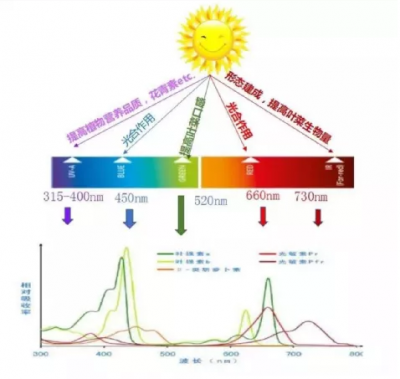LED plant growth lamp is an artificial light source that uses LED (light emitting diode) as the luminous body to meet the lighting conditions required for plant photosynthesis. Classified by type, it belongs to the third generation of plant supplement lamps. In the lack of daylight environment, this kind of lamp can act as daylight, so that plants can grow and develop normally or better.
Light environment is one of the important physical environmental factors that are indispensable for plant growth and development. Controlling plant morphology through light quality adjustment is an important technology in the field of facility cultivation; plant growth lamps are more environmentally friendly and energy-saving. LED plant lamps provide photosynthesis for plants, promote plant growth, shorten the time and it takes for plants to bloom and bear fruit, and increase production. In modernization, it is indispensable for crops. LED plant growth lamps have the following main technical points:
1. The color temperature and lumens of plant lights
The color temperature and lumens of plant lamps can be seen from the human eye, and the photosynthesis of plants does not look at the color temperature and lumens.
2. The effect of spectral range on plant growth lamps
Plant lighting has the function of strengthening roots, promoting growth, regulating flowering period and flower color, promoting fruit ripening and coloring, and enhancing taste and quality
280 ~ 315nm: minimal impact on morphology and physiological processes
315 ~ 400nm: Less absorption of chlorophyll, affecting photoperiod effect and preventing stem elongation
400 ~ 520nm (blue): The absorption ratio of chlorophyll and carotenoids is the largest, and has the greatest impact on photosynthesis
520 ~ 610nm (green): the absorption rate of the pigment is not high
610 ~ 720nm (red): Low chlorophyll absorption rate, which has a significant impact on photosynthesis and photoperiod effects
720 ~ 1000nm: Low absorption rate, stimulate cell elongation, affect flowering and seed germination
>1000nm: Converted into heat

The effect of spectral range on plant growth lamps

The effect of spectral range on plant growth lamps
PPF (photosynthetic photon flux)
PPF (Photosynthetic Photon Flux) refers to the number of micromoles of photons radiated by artificial light sources per second in the wavelength range of 400-700nm, and the unit is umol/s. The PPF value is not only the total value of the lamp, but also the total value of the lamp. The component of each interval is 100nm. This is because it is necessary to obtain the total PPF of the lamp, but also to understand the components of different wavelengths, it is the light formula; it can only be measured by LISUN LPCE-2(LMS-9000) High Precision Spectroradiometer Integrating Sphere System of plant growth lamps.
PF value of far red (700-800nm)
The PF value of far red (700-800nm) is listed separately. This is because far red is outside the range of photosynthetically effective radiation and cannot be characterized by PPF. In particular, lamps with far red PF greater than 5% need to calculate the far red PF maintenance rate for reporting;
PPE (photosynthetic photon efficiency)
PPE (photosynthetic photon efficiency) is greater than 1.9umol/J, and the lower limit is 1.8umol/J. Similar as the light effects of lighting fixtures, the plant lighting also sets the lowest light effect;
PPFD (photosynthetic photon flux density)
PPFD (Photosynthetic Photon Flux Density) and PPF correspond to the number of micromoles radiated by the light source per square meter per second, in umol/m2s, which is the concept of density. PPFD is a physical quantity related to the radiation distance. It is inversely proportional to the square of the irradiation distance.
1PPFD represents the number of photons per second of 1 micromole radiated on a surface of 1 square meter.
How big is 1umol/m2s (PPFD)? It means that there are 6 photons in 10 square nanometers.
YPFD: photon flux density produced
YPFD: The resulting photon flux density. Corresponding to YPF is the number of micromoles of radiation per square meter per second, unit umol/m2s, which is the concept of density.
YPFD is a physical quantity related to the radiation distance, which is inversely proportional to the square of the radiation distance.
YPFD can more accurately express the light quantity of LED plant light quality.
The relationship between PPFD and PPF: PPFD is the basic quantity derived from planting process parameters, and PPF is the main parameter for lamp manufacturing.

Plant Growth lamp test report
Lisun Instruments Limited was found by LISUN GROUP in 2003. LISUN quality system has been strictly certified by ISO9001:2015. As a CIE Membership, LISUN products are designed based on CIE, IEC and other international or national standards. All products passed CE certificate and authenticated by the third party lab.
Our main products are Goniophotometer, Integrating Sphere, Spectroradiometer, Surge Generator, ESD Simulator, EMI Receiver, EMC Test Equipment, Electrical Safety Tester, Environmental Chamber, Temperature Chamber, Climate Chamber, Thermal Chamber, Salt Spray Test, Dust Test Chamber, Waterproof Test, RoHS Test (EDXRF), Glow Wire Test and Needle Flame Test.
Please feel free to contact us if you need any support.
Tech Dep: Service@Lisungroup.com, Cell/WhatsApp:+8615317907381
Sales Dep: Sales@Lisungroup.com, Cell/WhatsApp:+8618917996096
Your email address will not be published. Required fields are marked *